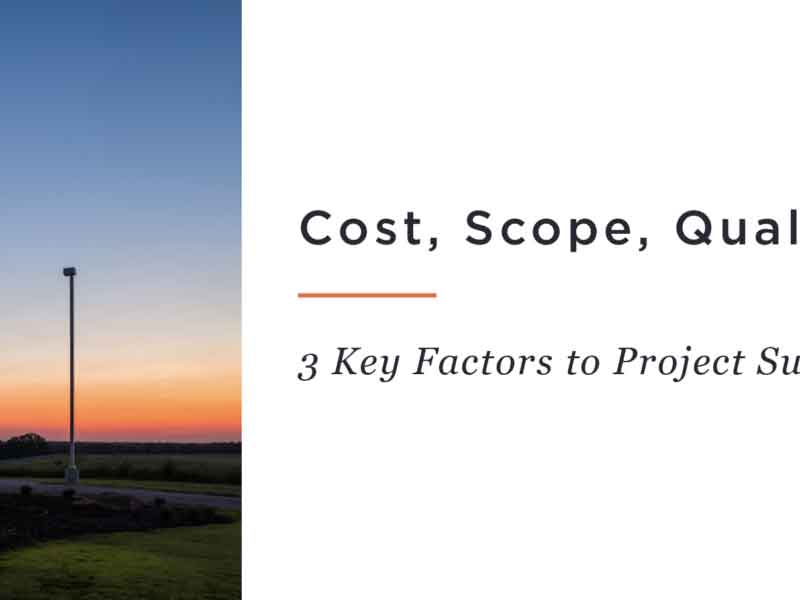Maybe your organization or company is getting ready to build a space that will let you achieve all your goals. Or perhaps you’re getting closer to your dream of a new home, built exactly as you’ve always wanted it. What do you need to know first?
Based on their years of experience working with clients like you, The Arkitex Studio’s co-founder, Charlie Burris, and senior partner, Eva Read-Warden, want you to go into your building project well-versed in the three factors that contribute to your final budget. Those factors: cost, scope and quality. And Burris cautions that you can control two of those three factors, but not all three.
“We can only control two of those things, and the other one is a product of those two,” Burris explains. “For instance, if you’re trying to control scope and the quality, well, that results in the cost (being uncontrolled).”
Looking Closer at the Three Factors
Why understand how these three factors interplay? After all, can’t you just go in to your first meeting with an architecture firm armed with a wish list of features and a final budget? Well, yes — but you’ll likely end up trying to control all three aspects, and that leads to less satisfaction, a more rocky project process and, often, higher costs that you were trying to avoid.
Let’s start by taking a closer look at these factors, which are tightly integrated.
Cost.
This is the number that you end up paying to get the project completed, but it includes more than simply what you pay for construction. Components of the final cost may include:
- Cost of the land.
- Professional fees for architects and engineers.
- Geotechnicall reports and surveys.
- Banking or financing fees.
- Legal fees.
- Interior design — your design firm will help with color selection and finishes, but you’ll still need furnishings and possibly artwork.
The Arkitex Studio has a project worksheet that outlines these different categories of expenses to help less experienced clients understand and properly budget for the entire project.
Scope.
Scope is probably the easiest of the three factors to wrap your head around. Scope basically applies to size — square footage — or any quantitative number. You need to have 5,000 square feet to accommodate your business? That’s scope. You want three classrooms in your daycare center? That’s scope.
Quality.
Quality is a little harder to define. It relates mostly to the types of materials you choose but also anything else that doesn’t realize to size or quantity.
“One thing we see is that clients think low quality means bad,” says Read-Warden. “It doesn’t necessarily mean bad — it’s just not high quality. Plastic laminate countertop in your kitchen isn’t bad, it’s just a different type of material than if you were able to put in granite or marble.”
Both Burris and Read-Warden caution that clients should always consider the life-cycle of materials and what the cost over time will be. You might choose to install high-efficiency, LED lighting in your new building. That’s a great choice because it will save you money on energy costs over time, but the fixtures themselves may be a higher upfront cost. Look at what will save you money over the life of the building when making quality choices.
How You Can Use the Three Factors to Your Advantage
Understanding how The Arkitex Studio works with these three factors can help you keep your project running smoothly and be completed on time and on budget.
Let’s say you choose scope and quality as your two factors. That means you’re willing to spend whatever it takes to meet your goals. But you could be in for a surprise when you actually see the cost — and that’s a shock that your architect wants to prevent.
“Particularly in the residential projects, people come in with a wish list of things they’ve always wanted in their home. ‘I’ve always wanted a library, I’ve always wanted a sewing room, I’ve always wanted a gun closet.’ All those things take space,” Burris says.
“So by the time they get through all their wishes, their house is 2,000 square feet larger than they wanted it to be, which has a big budget impact. They come in more focused on their wishes than their budget, so we have to constantly keep a reality check on what the consequences of those things are.”
To keep you in the loop and understanding how your choices impact the whole project, The Arkitex Studio starts with a very broad, conceptual perspective and works to define and narrow the solution as you move through the process. That helps the project evolve into a great finished building.
The most successful clients go through the process by being consistent and deliberate, Burris says. That means that you take the time to make well-thought-out decisions with the help of your project team. And then, you stick with those decisions.
“In this day and age when people have so much information at their fingertips, it’s easy for them to waffle on what their goal is,” Read-Warden notes. “Clients come in with ideas and images to give you a direction, but then they come in the next time and they’ve gone off in a whole different direction.”
Changes in direction take time and cost money. By understanding the planning process and being a fully involved client, you can get your building project off to a good start and keep it running smoothly through completion. Contact us to get started with your project.


